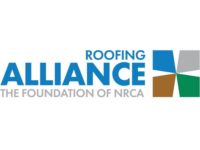Roofing Alliance Announces Release of Two New Reports

The Roofing Alliance, the foundation of the National Roofing Contractors Association (NRCA), announced the release of two new reports: A Study of the U.S. Roofing Industry and Its Workforce and Moisture in New Concrete Roof Decks. Both reports were funded by the Roofing Alliance in their ongoing commitment to the improvement of the roofing industry.
An aging population of workers, scarcity of skilled workers and an overall need to understand the demographics of the roofing industry were the motivations for the research project A Study of the U.S. Roofing Industry and Its Workforce. The Roofing Alliance funded the study to capture workforce demographics in support of programs to attract the next generation of the roofing workforce and to strengthen NRCA's voice and role in Washington, D.C. with statistical data that can be shared with regulatory and federal agencies.
“The industry has been ill-equipped to fully understand the magnitude of the challenges because of a lack of comprehensive workforce data and a detailed examination,” shared from the study’s executive statement. “To help fill this information gap, The Roofing Alliance commissioned Arizona State University in 2019 to study current roofing workforce demographics, types of work, skilled and unskilled labor shortages, and effects of labor shortages at national and regional scales, as well as industry challenges and potential solutions. A comprehensive survey methodology was adopted to collect data from roofing contractors throughout the U.S.”
The study comprehensively examines the demographics of the U.S. roofing workforce, including the contracting, manufacturing, distribution and design communities; explores types of operations; and analyzes industry challenges, trends and emerging issues. The final report summarizes that the labor shortage in the roofing industry is more severe than previously recognized. The study showed 90% of U.S. roofing contractors faced labor shortages during the past year with the west being the most severely affected by a lack of skilled workers.
A second but more long-term report, Moisture in New Concrete Roof Decks, was conducted between 2016 and 2019 with engineering researchers who conducted multiple experiments, measurements and computer simulations on new concrete roof test decks and roof systems installed over test decks. The results of this research has shown that with current roofing materials, the use of a vapor retarder or other concrete moisture mitigation techniques, such as venting, are needed when placing a roof system over a new concrete roof deck.
The research shows that the moisture content of a concrete roof slab may not drop to a level conservative enough to install a roof system over it in any reasonable amount of time after pouring concrete, or ever, without a vapor retarder or other moisture mitigation technique. This comprehensive report offers detailed information on why architects, engineers, contractors and especially roofing contractors should understand how to install roofing systems properly over new concrete roof decks.
Other industry associations and organizations that supported the study along with the Roofing Alliance include Chicago Roofing Contractors Association, Chicagoland Roofing Council, National Roofing Contractors Association, GAF, Soprema Inc., Johns Manville and the Canadian Roofing Contractors Association.
Both reports are available in the NRCA bookstore. The report: A Study of the U.S. Roofing Industry and Its Workforce is available in electronic format only and the Moisture in New Concrete Roof Decks is available as a hard copy only. (Due to a stay-at-home mandate issued for Illinois regarding COVID-19, NRCA is unable to ship hardcopy reports from its bookstore until further notice.)
For more information on the Roofing Alliance, visit www.roofingalliance.net or contact Bennett Judson at bjudson@roofingalliance.net.
Looking for a reprint of this article?
From high-res PDFs to custom plaques, order your copy today!



